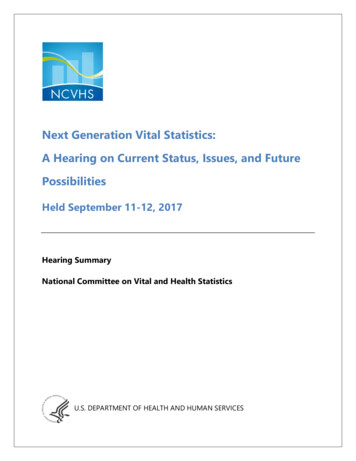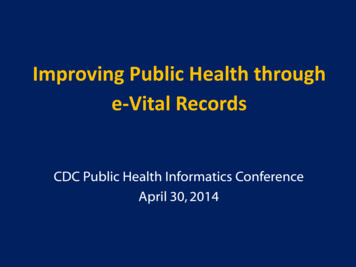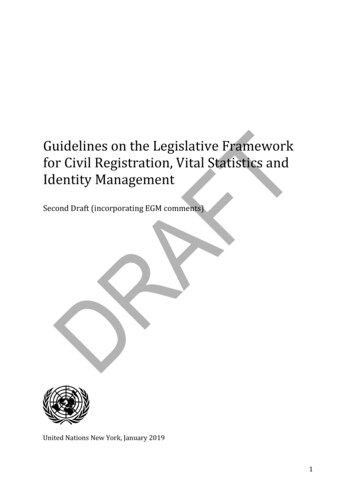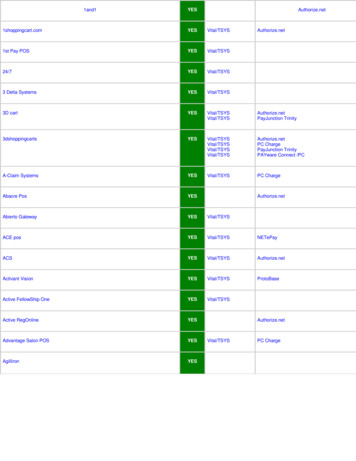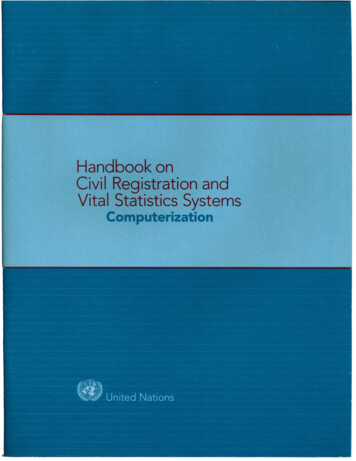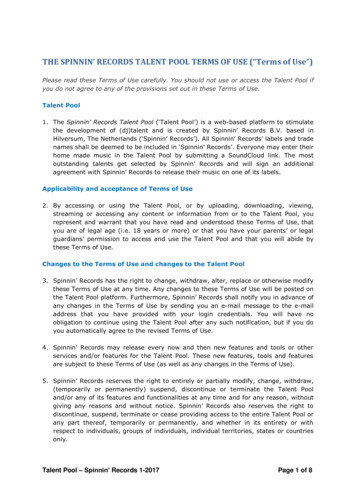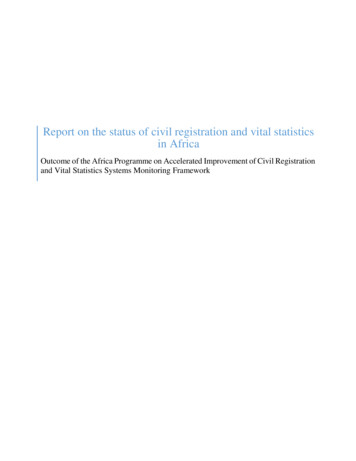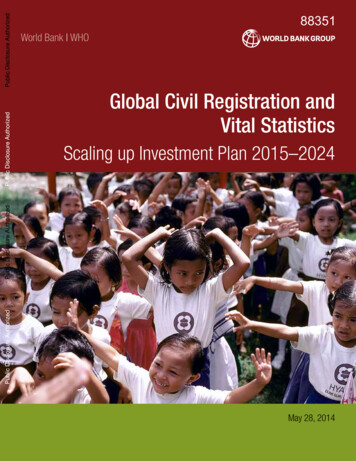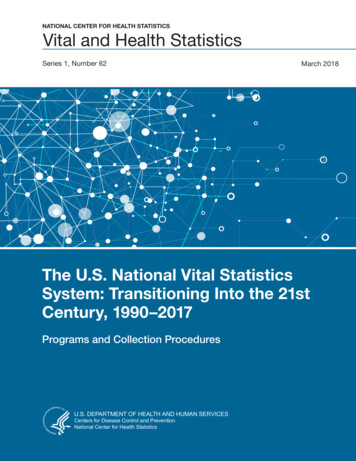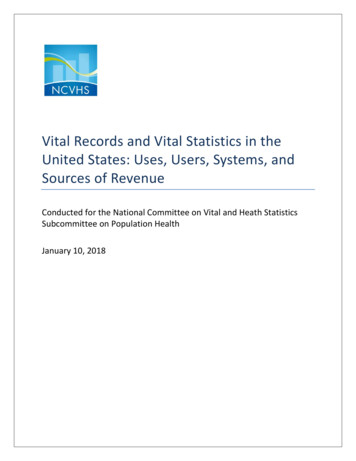
Transcription
Vital Records and Vital Statistics in theUnited States: Uses, Users, Systems, andSources of RevenueConducted for the National Committee on Vital and Heath StatisticsSubcommittee on Population HealthJanuary 10, 2018
Vital Records and Vital Statistics in the United States: Uses, Users, Systems, and Sources of RevenueThis report was prepared under contract by R. Gibson Parrish, M.D.NCVHS Membership and Lead Staff, Fall 2017William W. Stead, MD, NCVHS ChairBruce B. Cohen, PhD,* Subcommittee ChairLlewellyn J. Cornelius, PhD*Alexandra GossNicholas L. CoussouleLinda L. Kloss, MA, RHIA,Richard W. Landen, MPH, MBADenise E. Love *Vickie M. Mays, PhD, MSPH*Jacki Monson, JDRobert L. Phillips, Jr., MD, MSPH, Subcommittee ChairHelga Rippen, MD, PhD, MPH, FACPM*David A. Ross, ScD*Debra Strickland, MS*Roland J. Thorpe, Jr., PhD** Member of the Subcommittee on Population HealthKate Brett, PhD, Lead Staff to the Subcommittee on Population HealthEpidemiologistNational Center for Health Statistics, CDC, HHSRashida Dorsey, PhD, MPH, NCVHS Executive Staff DirectorDirector, Division of Data PolicySenior Advisor on Minority Health and Health DisparitiesOffice of Science and Data PolicyOffice of the Assistant Secretary for Planning and Evaluation, HHSRebecca Hines, MHS, NCVHS Executive Secretary/DFOHealth ScientistNational Center for Health Statistics, CDC, HHSThe National Committee on Vital and Health Statistics(NCVHS) serves as the advisory committee to the Secretary of Health and Human Services (HHS) onhealth data, statistics, privacy, national health information policy, and the Health Insurance Portabilityand Accountability Act (HIPAA) (42U.S.C.242k[k]). The Committee also serves as a forum for interactionwith interested private-sector groups on important health data issues. Its membership includes expertsin health statistics, electronic interchange of healthcare information, privacy, confidentiality, andsecurity of electronic information, population-based public health, purchasing or financing healthcareservices, integrated computerized health information systems, health services research, consumerinterests in health information, health data standards, epidemiology, and the provision of healthservices. Sixteen of the 18 members are appointed by the HHS Secretary to terms of four years each.Two additional members are selected by Congress. For more information, visit the NCVHS website:www.ncvhs.hhs.gov.January 2018Page 2 of 52
Vital Records and Vital Statistics in the United States: Uses, Users, Systems, and Sources of RevenueUpdated February 2018 with formatting changes.Table of ContentsBackground and Purpose . 4Terminology . 5Approach . 5Findings. 6Overview of birth and death registration .6Uses and users of identified birth and death records .8Uses and users of de-identified natality (birth) and mortality (death) data sets.16Sources of revenue for vital records offices .21Conclusions . 25References . 25Appendices . 28Appendix A. Abbreviations and acronyms used in report .28Appendix B. Brief descriptions of selected uses and users listed in tables and figures . 29Appendix C. Descriptions of selected information systems based on vital records that provide dataabout vital events to various users.32Death Master File (DMF). 32Electronic Verification of Vital Events (EVVE) . 35Electronic Verification of Vital Events Fact of Death (EVVE FOD). 37National Death Index (NDI) . 38State and Territorial Exchange of Vital Events system (STEVE) . 39Appendix D. List of persons certified to receive the Limited Access Death Master File as of June 1,2017 .43Appendix E. Cost estimate for Vital Records Systems in the United States.49Appendix F. Availability and cost of birth, death, and fetal death certificates and number of births,deaths, and fetal deaths registered, by vital registration jurisdiction, United States, 2016. . 50Appendix G. NCHS Vital Statistics Cooperative Program funding awarded for special projects, byvital registration jurisdiction, United States, 2013–2017. .52January 2018Page 3 of 52
Vital Records and Vital Statistics in the United States: Uses, Users, Systems, and Sources of RevenueBackground and PurposeThe National Committee on Vital and Health Statistics (NCVHS) serves as the advisory committee to theSecretary of Health and Human Services on health data, statistics, privacy, standards, national healthinformation policy, and the Health Insurance Portability and Accountability Act (HIPAA). In this capacity,it provides advice and assistance to the Department and serves as a forum for interaction withstakeholders on key issues related to population health, standards, privacy and confidentiality, and dataaccess and use. Because the national vital statistics system (NVSS) plays a critical role in monitoring thehealth of the nation, conducting public health surveillance, understanding the effectiveness of thehealthcare and health financing system, and supporting business and commerce, the NCVHS is exploringthe state of the existing NVSS and identifying ways to improve the system. The goal of NCVHS’exploration is the answer to the following question:“How do we transform today’s vulnerable vital records data collection network into anetwork of state systems that produce accurate and timely information supporting a breadthof local, state and federal data needs?”As part of this exploration, NCVHS held a “Hearing on Next Generation Vital Statistics” in Washington,D.C., on September 11–12, 2017. The hearing’s objectives were to:(1) identify the essential elements of the vital statistics system;(2) assess the system’s current status and risks to its viability; and(3) consider what actions are needed to protect and improve the system.At the hearing, more than 25 agencies, organizations, and businesses testified about their use of, andreliance on, vital records and statistics for carrying out their day-to-day activities. Representatives of theNVSS at the Federal, state, and local level also testified about the current status of the NVSS and itsongoing challenges. The agenda, testimony, and a transcript of the hearing are available on the NCVHSwebsite, 1 and a report summarizing the hearing is being prepared.Following the hearing, members of NCVHS with the support of the National Center for Health Statistics(NCHS) determined that it would be useful to develop a companion report that would provide asummary of the uses and users of vital records and vital statistics and an analysis of the types andsources of revenue available to vital records jurisdictions in the United StatesThe purpose of this report is to present the uses, users, and sources of revenue for vital records and vitalstatistics. The information provided in this report contributes to the input being considered by theCommittee as it identifies and considers recommendations for approaches that would address the manychallenges facing the NVSS at this time.NCVHS. Agenda: Next Generation Vital Statistics: A Hearing on Current Status, Issues and Future Possibilities,Hubert H. Humphrey Building, Room 705A, Washington, DC; September 11-12, 2017. Available ing/1January 2018Page 4 of 52
Vital Records and Vital Statistics in the United States: Uses, Users, Systems, and Sources of RevenueTerminologySeveral terms are used to describe different aspects of the NVSS:(1) Vital events are the major life events for individuals and include fetal death, still birth, birth,marriage, divorce, and death. The focus of this report is on two vital events: birth and death.(2) Vital registration is the process of collecting, recording, and storing specific information onindividual vital events. When this process is completed electronically, it is referred to as“electronic [vital event] registration”; examples include electronic birth registration andelectronic death registration.(3) Vital records are the product of vital registration and consist of the completed paper orelectronic forms that document vital events, such as birth certificates and death certificates.Vital records may be stored in either a paper or an electronic form.(4) Vital registration system consists of the various persons, agencies, equipment, forms, rules(standards), and processes that carry out vital registration. When this system completes vitalregistration electronically, it is referred to as an “electronic [vital event] registration system”;examples include electronic birth registration system (EBRS) and electronic death registrationsystem (EDRS).(5) Vital records office (VRO) is the government agency or organization within a state, local, orterritorial jurisdiction that is responsible for registering vital events, storing vital records, andissuing certified copies of vital records for legal and administrative purposes. In somejurisdictions, the VRO may be referred to as the “vital registration office” or the “vital statisticsoffice.”(6) Vital statistics consists of quantitative data concerning vital events in a population, such as thenumber of births and the death rate. Vital statistics are derived from an analysis of vital recordsdata.ApproachNCVHS contracted with R. Gibson Parrish, M.D., to prepare this report under the guidance of the NCVHSSubcommittee for Population Health, and Kate Brett, Lead Staff to the Population Health Subcommittee,and Rebecca Hines, NCVHS Executive Secretary, both with NCHS. Dr. Parrish prepared the report duringOctober and November 2017.To identify uses and users of vital records and vital statistics and the types and sources of revenueavailable to vital records offices in the United States, Dr. Parrish reviewed NCVHS Hearing-relatedmaterials, including the agenda, submitted testimony, and transcripts. Based on this review, he searchedthe Internet for agencies and organizations that produce, manage, support, or use vital records or vitalstatistics. The web sites identified in these searches are listed in association with the relevant table ortables in the findings section of this report and in this report’s list of references. Dr. Parrish alsointerviewed or corresponded with the following individuals to gain additional information on the NVSS,and he appreciates the assistance that they provided:(1) Delton Atkinson, Director of the Division of Vital Statistics at the National Center for HealthStatistics, Centers for Disease Control and Prevention(2) Kate Brett, Epidemiologist in the Division of Vital Statistics at the National Center for HealthStatistics, Centers for Disease Control and Prevention(3) Bruce Cohen, National Committee on Vital and Health Statistics(4) Rebecca Hines, Health Scientist, National Center for Health Statistics, Centers for DiseaseControl and PreventionJanuary 2018Page 5 of 52
Vital Records and Vital Statistics in the United States: Uses, Users, Systems, and Sources of Revenue(5) Rich McCoy, Director of the Center for Health Statistics at the Vermont Department of Health,and President-Elect of the National Association of Public Health Statistics and InformationSystems(6) Andrea Price, National Association of Public Health Statistics and Information Systems(7) Steven Schwartz, Registrar of the Bureau of Vital Statistics at the New York City Department ofHealth and Mental Hygiene(8) Anthony Stout, National Association of Public Health Statistics and Information Systems(9) Shawna Webster, Executive Director, National Association of Public Health Statistics andInformation SystemsFindingsOverview of birth and death registrationFigures 1 and 2 provide overviews of the birth and death registration processes, respectively. Bothfigures show the process of gathering information about the vital event on the left, including the typesof people and organizations involved in the process. The middle panels depict the roles of stategovernment in registering the vital event and providing data about vital events to various state andnational users. The right panels depict major national agencies and organizations that compile, use, anddistribute birth and death records obtained from state vital records offices. The figures also depictpayments made by various users of vital records to state or national organizations for the use of therecords. 2January 2018Page 6 of 52
Vital Records and Vital Statistics in the United States: Uses, Users, Systems, and Sources of RevenueFigure 1. Current birth registration process for a state vital records jurisdictionLegend for Figure 1:–––– Solid black and green lines denote typical processes and payments, respectively- - - - Dashed black and green lines denote other, less common processes and payments, respectively2Payments by users to providers of vital records or vital statistics data are shown by green lines with “ ”.DMV Department of Motor VehiclesEAB Enumeration at BirthEBRS Electronic Birth Registration SystemEHR-S Electronic Health Record SystemEVVE Electronic Verification of Vital EventsIIS Immunization Information SystemNBS Newborn ScreeningNCHS National Center for Health StatisticsOB Obstetrician or comparable health care providerJanuary 2018Ped PediatricianSAMS Secure Access Management ServicesSHD State Health DepartmentSSA Social Security AdministrationSSN Social Security NumberSTEVE State and Territorial Exchange of Vital Events SystemVRS Vital Registration SystemVSCP Vital Statistics Cooperative ProgramPage 7 of 52
Vital Records and Vital Statistics in the United States: Uses, Users, Systems, and Sources of RevenueFigure 2. Current death registration process for a state vital records jurisdictionLegend for Figure 2:–––– Solid black and green lines denote typical processes and payments, respectively- - - - Dashed black and green lines denote other, less common processes and payments, respectivelyCMS Centers for Medicare and Medicaid ServicesCR Cancer RegistryDMF Death Master FileDMV Department of Motor VehiclesDoD U.S. Department of DefenseDoS U.S. Department of StateED Emergency DepartmentEDRS Electronic Death Registration SystemEHR-S Electronic Health Record SystemEVVE Electronic Verification of Vital EventsEVVE FOD Electronic Verification of Vital Events Fact of DeathIIS Immunization Information SystemLADMF Limited Access Death Master FileME/C Medical Examiner / CoronerNCHS National Center for Health StatisticsNDI National Death IndexNTIS National Technical Information ServiceNVDRS National Violent Death Reporting SystemSAMS Secure Access Management ServicesSHD State Health DepartmentSSA Social Security AdministrationSTEVE State and Territorial Exchange of Vital Events SystemVRO Vital Records OfficeVRS Vital Registration SystemVSCP Vital Statistics Cooperative ProgramUses and users of identified birth and death recordsUses and users of identified 3 birth and death records are shown in Tables 1 and 2, respectively. Theseuses and users include individuals who use their birth certificate to establish their identity for variouslegal and administrative purposes; the Social Security Administration (SSA), which uses birth data tofacilitate the issuance of Social Security Numbers (SSN) to persons born in the United States and deathdata to terminate the payment of benefits; and private organizations, which use death data to paybenefits and to prevent fraud.“Identified records” refers to one or more of records, each of which contains information sufficient to identity thesubject of the record, such as name, name of mother, and location and date of birth on a birth record.3January 2018Page 8 of 52
Vital Records and Vital Statistics in the United States: Uses, Users, Systems, and Sources of RevenueThese identified birth and death records are available through state and other vital records offices(VROs) to authorized individuals, who usually must pay a fee for copies or use of the records.Verification of birth and death records is also available to authorized users for all state and other vitalrecords jurisdictions—except New York and Texas—through the Electronic Verification of Vital Events(EVVE) system, which is maintained by the National Association of Public Health Statistics andInformation Systems (NAPHSIS). NAPHSIS also operates the Electronic Verification of Vital Events Fact ofDeath (EVVE FOD) system, which provides authorized users with the ability to discover if a death recordexists for an individual. Currently, 42 states and jurisdictions participate in the EVVE FOD system. (SeeAppendix C and Table 5.)The Social Security Administration purchases identified birth and death records from VROs to administerits benefits programs. These records form a part of the NUMIDENT electronic database, which containsSSA’s records of Social Security Numbers (SSN) assigned to individuals since 1936. The SSA compiles itsdeath information in the Death Master File (DMF), which is an extract of death information onNUMIDENT (see Appendix C). The DMF includes, if available, each deceased individual’s SSN, first name,middle name, surname, date of birth, and date of death. The SSA provides access to the “full” DMF for a“reasonable cost” to Federal or state agencies that provide federally funded benefits to individuals. TheSSA may also provide State driver’s license agencies with access to its records to verify applicableinformation “pursuant to the Help America Vote Act of 2002.” (See Appendix C and Table 5.)A “public” version of the DMF contains death records extracted from the NUMIDENT database, butdoes not include death data received from the states. The “public” version of the DMF is available fromthe Department of Commerce’s National Technical Information Service (NTIS) as the “Limited AccessDMF,'' or “LADMF,” to certified persons and organizations, who must have a legitimate fraud preventioninterest, or have a legitimate business purpose pursuant to a law, governmental rule, regulation, orfiduciary duty. The NTIS charge fees for using the LADMF and to cover the costs associated with itscertification program. (See Appendix C and Table 5.)NCHS established and maintains the National Death Index (NDI), a centralized database of death recordinformation on file in state vital statistics offices, as a resource to aid epidemiologists and other healthand medical investigators with their mortality ascertainment activities. Researchers pay a fee for usingthe NDI and can request either a routine NDI search for those who do not need cause of death codes, oran NDI Plus search, which also provides cause of death codes. (See Appendix C and Table 5.)Table 1. Uses of identified birth records and data setsUseIndividual or FamilyEstablish identity for legaland administrative purposesUser(s)SystemIndividual or familyObtain or renew U.S.PassportIndividual or familyProvide proof of citizenshipor legal residency foremploymentIndividual personState andjurisdictionVROsState andjurisdictionVROsState andjurisdictionVROsJanuary 2018RecordsusedVRO Fundingsource1Sale ofcertificate1Sale ofcertificate1Sale ofcertificatePage 9 of 52
Vital Records and Vital Statistics in the United States: Uses, Users, Systems, and Sources of RevenueVerify identity for driverslicense or identity cardIndividual personVerify age of child for sportsleagueIndividual or familyProvide proof of country ofbirth for college admissionIndividual personFederal GovernmentVerify and certify birthinformationIssue Social Security Number(SSN) to each newborn toprevent other parties fromfiling a request for a SSN inthe name of the newbornObtain or renew U.S.PassportState andjurisdictionVROsState andjurisdictionVROsState andjurisdictionVROs1Sale ofcertificate1Sale ofcertificate1Sale ofcertificateSSADoS/DiplomaticSecurityOPMRegional FBI OfficesDHS/USCISSSAEVVE*EVVE*1 to many1 to manyUser feeUser feeEVVE*EVVE*EVVE*State andjurisdictionEBRS1 to many1 to many1 to manyAll birthsUser feeUser feeUser feeSSA contractswith StateVROsDoS/Passport ServicesFraud PreventionOfficesState andjurisdictionVROsEVVE*State andjurisdictionVROs1 to manyUnknown†1 to many1 to manyUser feeCMScontractorpayments toVRONCHS (VSCP)Conduct evaluations of stateMedicaid programsCMSObtain birth certificatedemographic and medicaldata for the National VitalStatistics SystemState and Local GovernmentAssist state and localgovernment agencies inperforming their officialduties*Enroll eligible children intoMedicaid programNCHSState andjurisdictionEBRSAll birthsSecretary of StateEVVE*SelectedbirthsUser feeState MedicaidprogramsSelectedbirthsUnknown†Verify identity for driver’slicense or identity cardDMVState andjurisdictionVRO/EBRSEVVE*State andjurisdictionVROsEVVE*SSA birth fileVerify birth for voterJanuary 2018DMVSelectedbirthsSelectedUser feeUnknown†User feeNone: BirthPage 10 of 52
Vital Records and Vital Statistics in the United States: Uses, Users, Systems, and Sources of RevenueregistrationInitialize entry inImmunization InformationSystem (IIS)Facilitate newborn screeningfor health disordersState IISHealth care providerresponsible forscreening newbornPrivate (Non-Government) OrganizationsGenealogical researchIndividual person ororganizationVerify age of child for sportsleagueSport leagueUse by media to verifyidentity or other informationMedia organizationsUse of birth data for medicalor other health researchMedical and otherhealth researchersConduct background checksfor government agencies,pension funds, or otherorganizations (Note: Somestates can’t providecertificates to these thirdparties.)Determine property rightsand place them in landrecordsMarketing products toparents of newborns. (Note:Some states can refuse theserequests.)Company undercontract togovernment agency orpension fund (e.g.,Berwyn Group)Title search companiesMarketing companiesstates andbirthsAlldata obtainedfrom SSAUnknown†AllUnknown†State andjurisdictionVROsState andjurisdictionVROsState andjurisdictionVROsState andjurisdictionVROsState andjurisdictionVROs1 to manySale ofcertificate(s)or VR dataSale ofcertificate(s)State andjurisdictionVROsState andjurisdictionVROs1 to manyState andjurisdictionEBRSState andjurisdictionVRO/EBRS1 to many1 to many1 to many1 to manyManySale ofcertificate(s)or VR dataSale ofcertificate(s)or VR dataSale ofcertificate(s)or VR dataSale ofcertificate(s)or VR dataSale ofcertificate(s)or VR data* For information on births occurring in states or jurisdictions not participating in EVVE, the user must contact thestate or jurisdiction’s VRO for information about birth records.† The author of this report was unable to find the information needed to fill in this cell in this table. The VROsource of funding may differ by jurisdiction.Sources of information for Table 1:(1) NAPHSIS: About EVVE FOD. Available at https://www.naphsis.org/evve-fod; accessed on 4 Oct2017.(2) Personal communication with Rich McCoy, Vermont State Registrar and Chief, Center for HealthStatistics, 13 Oct 2017.(3) Presentations at NCVHS hearing, September 11-12, 2017, Washington, D.C., available ing/; accessed on 4 OctJanuary 2018Page 11 of 52
Vital Records and Vital Statistics in the United States: Uses, Users, Systems, and Sources of Revenue2017.Table 2. Uses of identified death records and data setsUseIndividual or FamilyEstablish fact of death forlegal and administrativepurposes. Note: DeathCertificate cannot beprovided to funeraldirectors in all states.Federal GovernmentAssist federal governmentagencies in performing theirofficial duties (FederalAdministrative Use)*Establish fact and cause ofdeath to pay death benefit,or terminate paymentsunder retirement or otherbenefit programsEstablish fact of death toterminate, redirect, orotherwise modify SocialSecurity payments or otherbenefitsAssist federal governmentagencies in paying deathbenefits, or terminatingpayments under disability,unemployment, workers’compensation, pension,retirement, or other benefitprogramsJanuary 2018VRO FundingsourceUserSystemRecords usedFamily of decedentState andjurisdictionVROs1Purchase ofcertificate(s) byindividual,family, orfuneral directorEVVE FOD†EVVE FOD†EVVE FOD†EVVE FOD†EVVE FOD†EVVE FOD†Full DMF1 to many1 to many1 to many1 to many1 to many1 to manyActive dutymilitarydeathsUser feeUser feeUser feeUser feeUser feeUser feeNone: DMFobtained fromSSAVAFull DMF†Federal RetirementThrift InvestmentBoardOPMFull DMF†HUDUSDA/FSAUSDA/NRCSUSDA/RMASSAFull DMF†Full DMF†VeterandeathsDeaths offederal civilianand ��State andjurisdictionEDRSAll deathsSSA contractswith State VROsDoL/OWCPUnknown††Deaths ofcertain civilianemployeesUnknown††Examples of users:DHSDoSIRSNIOSHU.S. TreasuryVADoD/DefenseManpower DataCenterFull DMF†Page 12 of 52
Vital Records and Vital Statistics in the United States: Uses, Users, Systems, and Sources of RevenueUseEstablish fact of death toterminate benefitsVerify deaths of individualsto prevent tax fraud by useof identities of recentlydeceased individuals toclaim tax refundsIdentify and obtaininformation about deathsdue to specific causesIdentify health studysubjects who have diedIdentify health studysubjects who have died, ifresearcher can’t obtainrecords quickly enoughthrough NDI, or researchproposal is rejected by NDI,or researchers only needrecords from one or twostatesState and LocalGovernmentAssist state and localgovernment agencies inperforming their officialduties (State/localAdministrative Use)*Assist state and localgovernment agencies inpaying death benefits, orJanuary 2018SystemFull DMF†Full DMF†Pension BenefitGuarantyCorporationFull DMF†IRSFull DMF†CPSCState andjurisdictionVROsNDISelecteddeathsSale ofcertificatesAll deathsNDI user feesState andjurisdictionVROsSelecteddeathsSale ofcertificatesEVVE FOD†1 to manyUser fees paidby state andlocalgovernmentagenciesLADMF†1 to manyEVVE FOD†AllNone: NTIS UserfeesUser fees paidby state andlocalCDCCensus BureauCMSDoDNIHNIH or otherfederal agencyExamples of users:CountygovernmentDMVLaw enforcementSecretary of StateSocial servicesSee Appendix DState and localgovernmentpension plansRecords usedAll deathsDeaths ofrailroadworkers andtheir familiesDeaths ofpersonscovered byPBGCAll deathsVRO FundingsourceNone: DMFobtained fromSSAUserCMSU.S. RailroadRetirement BoardNone: DMFobtained fromSSAPage 13 of 52
Vital Records and Vital Statistics in the United States: Uses, Users, Systems, and Sources of RevenueVRO FundingsourcegovernmentagenciesUseUserterminating paymentsUnemploymentunder disability,programsunemployment, workers’Workers’compensation, pension,compensationretirement, or other benefit programprograms (State/localBenefit Use)Private (Non-Government) OrganizationsAssist financial institutionsExamples of users:in verifying legitimacy andCitigrouplegal ownership of financial Equifaxtransactions, such asFidelityinvestments, loans andNorthern Trustdeposits.Assist healthcareExamples of users:organizations inAscension Healthdetermining whetherTenet Healthcarepatients survive care and in Trinity Healthremoving decedents fromtheir files (HealthcareAdministrative Use)Determine property rightsTitle searchand enter them in landcompaniesrecordsEstablish fact and cause ofLife insurancedeath to pay benefitcompaniesSystemRecords usedEVVE FOD†EVVE FOD1 to manyEVVE FOD†1 to manyUser fees paidby health careorganizationsState andjurisdictionVROs1 to manySale ofcertificate(s)1Assist insurance companiesin identifying insuredindividuals who have died,providing warrantedbenefits to beneficiaries,and in complying withapplicable state lawsEstablish fact of death toterminate payments orother benefitsExamples of users:MetLifeState FarmSee Appendix DEVVE FOD†1 to manyNone:Certificateobtained fromdecedent’sfamilyUser feeLADMF†1 to manyNone: User feespaid to NTISEmployer-basedpension orretirement plansEVVE FOD†Selecteddeaths1 to
(6) Vital statistics consists of quantitative data concerning vital events in a population, such as the number of births and the death rate. Vital statistics are derived from an analysis of vital records data. Approach NCVHS contracted with R. Gibson Parrish, M.D., to prepare this report under the guidance of the NCVHS
